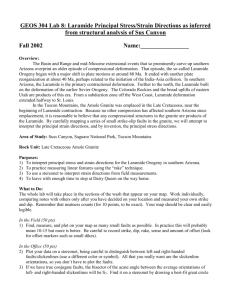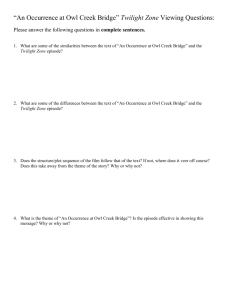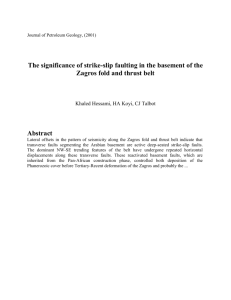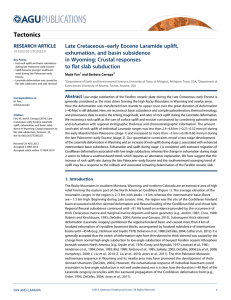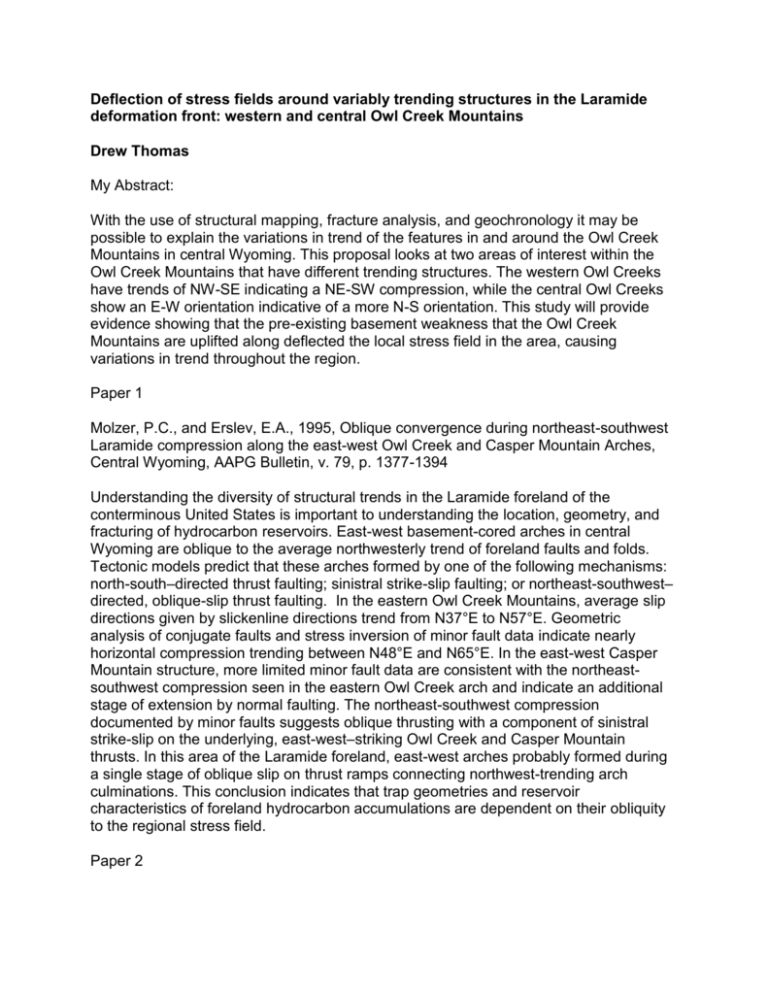
Deflection of stress fields around variably trending structures in the Laramide
deformation front: western and central Owl Creek Mountains
Drew Thomas
My Abstract:
With the use of structural mapping, fracture analysis, and geochronology it may be
possible to explain the variations in trend of the features in and around the Owl Creek
Mountains in central Wyoming. This proposal looks at two areas of interest within the
Owl Creek Mountains that have different trending structures. The western Owl Creeks
have trends of NW-SE indicating a NE-SW compression, while the central Owl Creeks
show an E-W orientation indicative of a more N-S orientation. This study will provide
evidence showing that the pre-existing basement weakness that the Owl Creek
Mountains are uplifted along deflected the local stress field in the area, causing
variations in trend throughout the region.
Paper 1
Molzer, P.C., and Erslev, E.A., 1995, Oblique convergence during northeast-southwest
Laramide compression along the east-west Owl Creek and Casper Mountain Arches,
Central Wyoming, AAPG Bulletin, v. 79, p. 1377-1394
Understanding the diversity of structural trends in the Laramide foreland of the
conterminous United States is important to understanding the location, geometry, and
fracturing of hydrocarbon reservoirs. East-west basement-cored arches in central
Wyoming are oblique to the average northwesterly trend of foreland faults and folds.
Tectonic models predict that these arches formed by one of the following mechanisms:
north-south–directed thrust faulting; sinistral strike-slip faulting; or northeast-southwest–
directed, oblique-slip thrust faulting. In the eastern Owl Creek Mountains, average slip
directions given by slickenline directions trend from N37°E to N57°E. Geometric
analysis of conjugate faults and stress inversion of minor fault data indicate nearly
horizontal compression trending between N48°E and N65°E. In the east-west Casper
Mountain structure, more limited minor fault data are consistent with the northeastsouthwest compression seen in the eastern Owl Creek arch and indicate an additional
stage of extension by normal faulting. The northeast-southwest compression
documented by minor faults suggests oblique thrusting with a component of sinistral
strike-slip on the underlying, east-west–striking Owl Creek and Casper Mountain
thrusts. In this area of the Laramide foreland, east-west arches probably formed during
a single stage of oblique slip on thrust ramps connecting northwest-trending arch
culminations. This conclusion indicates that trap geometries and reservoir
characteristics of foreland hydrocarbon accumulations are dependent on their obliquity
to the regional stress field.
Paper 2
Erslev, Eric A., Koenig, Nicole V., 2009, Three-dimensional kinematics of Laramide,
basement-involved Rocky Mountain deformation,
USA: Insights from minor faults
and GIS-enhanced structure maps, In Kay, SM, Ramos, V.A., Dickinson, W.R. M.S.
eds. Backbone of the Americas: shallow subduction, plateau uplift, and ridge and
terrane collision, p. 125-148
•
Contractional, basement-involved foreland deformation in the Rocky Mountains of the
conterminous United States occurred during the latest Cretaceous to Paleogene
Laramide orogeny. Current kinematic hypotheses for the Laramide orogeny include
single-stage NE- to E-directed shortening, sequential multidirectional shortening, and
transpressive deformation partitioned between NW-striking thrust and N-striking strikeslip faults. In part due to this kinematic uncertainty, the links between Laramide
deformation and plate-margin processes are unresolved, and proposed driving forces
range from external stresses paralleling plate convergence to internal stresses due to
gravitational collapse of the Cordilleran thrust belt. To determine the tectonic controls on
Laramide deformation, kinematic data from minor faults (n = 21,129) were combined
with a geographic information system (GIS) database quantifying Rocky Mountain
structural trends. Minor fault data were collected from a variety of pre-Laramide units to
calculate average Laramide slip (N67E-01) and maximum compressive stress (N67E02) directions for the Rocky Mountains. These largely unimodal, subhorizontal slip and
compression directions vary slightly in space; more E-W directions occur in the southern
and eastern Rockies, and more NE-SW directions are found near the Colorado Plateau.
This kinematic framework was extended to the entire orogen using map data for faults,
folds, arches, and Precambrian fabrics from Wyoming, Colorado, northern New Mexico,
southeastern Utah, and northeastern Arizona. Vector mean calculations and lengthweighted rose diagrams show that Precambrian fabrics are at a high angle to most
larger Phanerozoic structures but are commonly reactivated by smaller structures.
Ancestral Rocky Mountain structures are subparallel to Laramide structures, suggesting
similar tectonic mechanisms. Laramide faults, defined by their involvement of Mesozoic
and Paleogene strata but not Neogene strata, are complex, and preexisting
weaknesses and minor strain components commonly predominate. In contrast,
Laramide fold (avg. N24W) and arch (avg. N23W) axis trends are oriented
perpendicular to minor fault slip and compression directions due to their generation by
thrust-related folding. Laramide deformation shows the primary external influence of
ENE-directed shortening paralleling published convergence vectors between the North
American and Farallon plates. Slightly radial shortening directions, from more NEdirected to the north to more E-directed to the south, suggest focused contraction
originating near current-day southern California. A slight clockwise rotation of shortening
directions going from west to east is consistent with proposed changes in Farallon-North
American plate trajectories as the orogen expanded eastward. Additional complexities
caused by localized preexisting weaknesses and impingement by the adjoining
Cordilleran thrust belt have provided structural diversity within the Laramide province.
Obliquities between convergence directions and the northern and southeastern
boundaries of the Laramide province have resulted in transpressive arrays of en
echelon folds and arches, not major through-going strike-slip faults. © 2009 The
Geological Society of America. All rights reserved.

